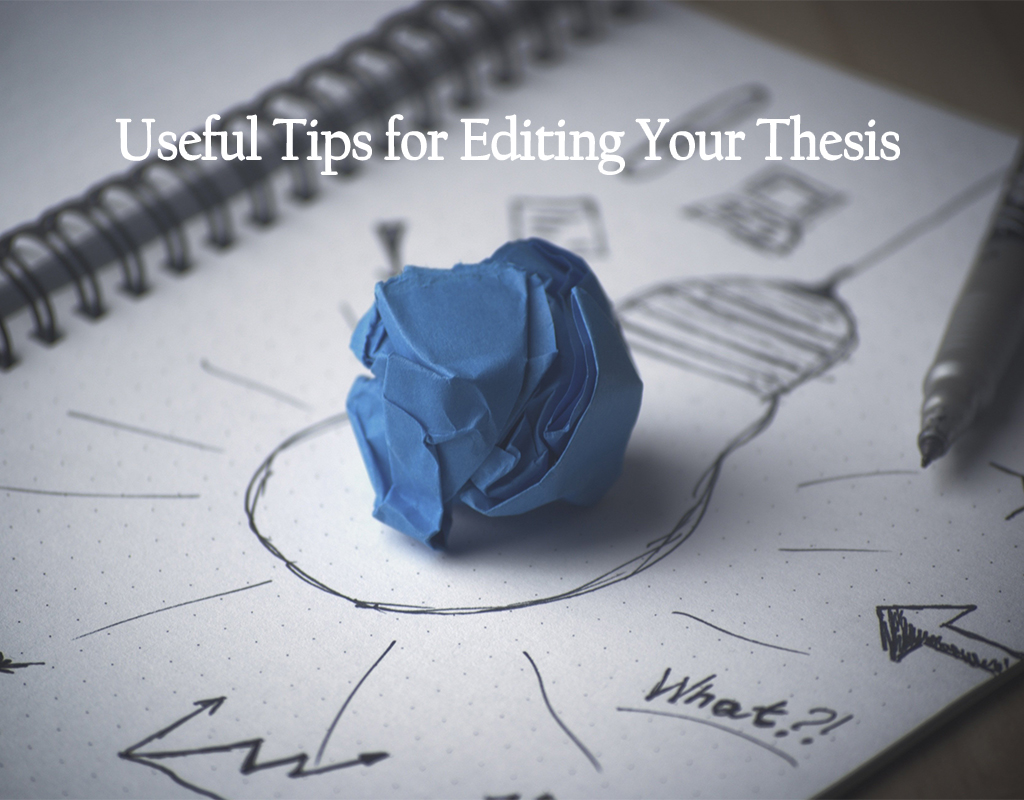Useful Tips for Editing your Thesis
Even after a thesis is complete, important work remains to be done before the thesis can be finally submitted to the university or to a publisher and that is editing. Editing is required for the best presentation of your thesis to the readers. It is all about making it easier for readers to read and analyse your work.
Editing is done mainly for the structure, grammar, language and style.
Editing for structure helps readers follow the logic of your argument; research thesis is written in a specific format following certain regulations of the discipline, which embody the objective of the work.
Editing for language and style is done for revision on the narrative such that consistent flow of writing can help readers focus on the content.
Editing in the form of Proof reading gets rid spelling errors and punctuation dissimilarities, formatting inconsistencies and other distractions to allow readers to focus on the writing.
Structural editing in a thesis need to focus firstly on the basic format and structure of research, the elements of the research i.e. Abstract, Introduction, Literature Review, Methodology, Discussion, Conclusion, Recommendation and Bibliography.
Introduction need to define the topic and explain the purpose of work with an outline of argument.
The individual chapters of research should be edited with the following questions in mind
-are the chapters ordered logically
– are the chapters divided into appropriate sections
– does each chapter have appropriate introductory and concluding sections
– is the material in the chapter ordered logically
– does the argument flow smoothly between paragraphs
– does each paragraph clearly state its topic
– does each sentence make sense
– are the details, examples and explanations adequately developed.
The Conclusion needs to be linked to the Introduction. The conclusion should specifically sum up all the arguments in the research and direct the work towards a resultant statement. Recommendation for future work forms a part of the conclusion which can be included for additional scope.
The conclusion is followed by Bibliography. Bibliography should acknowledge all the works properly, which have helped in formulating the thesis, books, articles and web journals, all materials that have been cited in the paper and those which have inspired the work. Bibliography should be in correct format, i.e. MLA, APA or whichever the author chooses to use. Moreover, the format should be consistent; these pointers should be checked while editing the thesis.
General Pointers for Language and Style are as follows
-Use of a formal, academic style.
– Style and conventions (e.g. use of first person, I) can vary between disciplines
– Seek advice and read other theses in your discipline to gauge the appropriate style.
– Seek help on written English as early as possible, if necessary.
– Make sure every sentence is grammatically correct and logically connected.
The final check point in a research thesis is the proofreading part. Proof reading includes checking both accuracy of text and consistency of layout.
While checking on the layout, following should be kept in mind:
- Margins and indents for main text and also for indented quotations, bullets etc.
- Tile and Subtitle- Title should be more prominent and subtitle less prominent. If the title runs across more than one line, make sure it is broken up into logical chunks.
- Headings and subheadings need to be accurate and consistently formatted (font size, type, spacing before and after) throughout – also check that numbering (if any) is consistent and that headings are accurately reflected in the contents listing.
- Spacing – before and after headings, paragraphs, figures, etc.
- Page numbers should be sequenced properly.
- Font size / font style of headings, subheadings, captions, main body of text, quotes, headers, footers, notes
- Figures and tables should be numbered properly.
- Headers (if any) should not appear with title (e.g. contents page, first page of each chapter, etc.)
Next should be the check for the main text-
- All sentences must start with capital letter.
- New paragraph should be on new line.
- Spacing after comma, full-stop, semi-colon etc. should be checked. Also, put a single space before and after the bracket.
- Avoid double spacing.
- Quotation marks for citing textual portions from another work, should be used.
- Check for closing of all opened brackets.
- Check if full-stop has been given at the end of every sentence.
- In the References section, check for consistency in italics (for title of awork or article).
- Abbreviations – check that these are spelt out in full the first time they are used with the abbreviation put in brackets following. Subsequently, the abbreviation only should be used.
Some necessary tips for editing your research thesis are following-
- Organize the structure of the paper before you start writing
- Make a note of all the resources and reference works beforehand
- Do a research on the market trend.
- Know the guidelines of the discipline, journal or university in which you are submitting your research work.
- Consult a specialist or expert for editorial work
- Do some homework on editing thesis through offered courses.
- Use professional software for editing your research thesis.
Editing is like a backbone to a good research thesis. Doing is right is very important. The above tips and tricks can help edit your work such that it complies to the scope of your destination journal and your readers at large.


Very useful information for researchers
i like the way editing
Thank you for sharing this useful information
i like it and getting worthy!
really interesting.